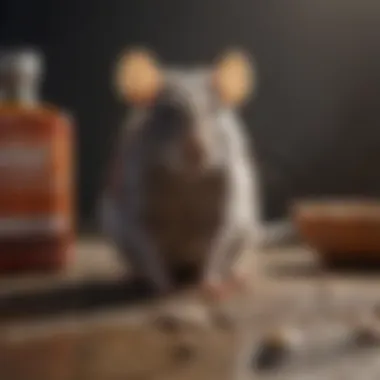Buying Rat Poison: A Comprehensive Guide


Intro
As urban areas grow, so do the challenges associated with pest control, especially concerning rodent infestations. Understanding the dynamics of these infestations can greatly assist housewives and homeowners in navigating the complexities of effective pest management. Rat infestations can have significant implications for health, sanitation, and property integrity, making it crucial to address them efficiently.
This guide will not only focus on buying rat poison but will also consider how to identify the problem, prevent further infestations, and the methods available for controlling the rodents effectively. There is much to explore regarding types of rat poison, their regulations, safety in handling, and alternatives that could be environmentally friendly.
Understanding the Pest
Identification
To deal with a rat infestation, it is essential first to identify the species involved. Common types of rats include the Norway rat and the roof rat. Norway rats are typically brown or gray, have a stocky build, and prefer burrowing in the ground. In contrast, roof rats are sleek and agile, often found climbing in attics and trees. Knowing which rat you are dealing with can influence the choice of poison and the application strategy.
Life Cycle
Understanding the life cycle of rats is vital for effective control. Rats reach maturity quickly, typically within three months, and can reproduce multiple times a year. A female rat can have litters of 6 to 12 pups, which means an initial small infestation can rapidly grow. Recognizing this cycle aids in evaluating the urgency of eradicating the problem and choosing appropriate control measures.
Pest Prevention Strategies
Environment Modification
Preventing rat infestations often starts with modifying the environment. Key modifications include:
- Keeping food stored in airtight containers
- Closing off entry points in walls and foundations
- Maintaining cleanliness in and around the home
- Removing sources of shelter, like low vegetation or debris
Addressing these factors reduces the chances of a rat infestation, making your living space less inviting.
Physical Barriers
Physical barriers can be very effective in preventing rat access. Steel wool can be used to block holes, and door sweeps can close gaps. In more significant implementations, installing rat guards or mesh screens on vents can deter access without major modifications to the home.
Control Methods
Chemical Control
When prevention fails, chemical control becomes necessary. Rat poisons come primarily in two types: anticoagulants and non-anticoagulants. Anticoagulants cause internal bleeding over a period of days, while non-anticoagulants serve to kill the rat swiftly. Among the most common rat poison brands are D-Con and Bait Block. Understanding the active ingredients and potential risks is vital when choosing the right product to use.
Application Methods
- Bait stations should be placed in areas where rat activity is evident.
- Always follow the manufacturer’s instructions for safe application and disposal.
- Ensure any poison used is out of reach of children and pets.
Biological Control
While less common, biological control methods can also be utilized. This involves using natural predators or parasites to control rat populations. However, these methods are complicated and generally less effective for immediate infestations. They may require more time, observation, and expertise to implement successfully.
Using rat poison is significant not just for immediate control but also has far-reaching implications. Take educated steps to ensure safety and effectiveness.
The End
Prelude to Rat Poison
Rat infestations present a persistent challenge for many homeowners, often leading to property damage and potential health risks. This section aims to establish a foundational understanding of rat poison as a crucial tool in managing these infestations efficiently. The right knowledge assists in making informed decisions about pest control.
Understanding Rat Infestations
Rats can infiltrate homes, seeking shelter and food. Their presence can escalate into serious infestations if not addressed promptly. Common species include the Norway rat and the roof rat, each exhibiting distinct behavior patterns.
These pests reproduce rapidly, leading to escalating challenges in control. Found in urban and suburban settings, rats often thrive in environments offering warmth and accessibility to food. Recognizing the signs of infestation, like droppings or gnaw marks, is essential for effective management.
Why Rat Poison?
Using rat poison is one common method employed to address these challenging situations. While traps can be effective, they may not provide a comprehensive solution for larger infestations. Rat poison acts decisively to reduce the population when utilized correctly. Safely employing this approach enables homeowners to regain control of their environment.


When deciding on the application of poison, consideration must be given to the types available, effectiveness, and safety. As with any pest control method, familiarizing oneself with the potential risks is necessary. This ensures that the chosen strategy aligns with household safety and broader environmental concerns.
"Understanding both the predator and prey dynamics forms the backbone of any pest management strategy."
In succeeding sections, we will delve deeper into the various types of rat poison, purchasing considerations, and essential safety regulations.
Types of Rat Poison
Understanding the various types of rat poison is crucial for making informed decisions about pest control. Not all poisons work the same way; they have different modes of action, effectiveness, and risks to the environment and other species. Choosing the right one can help ensure the intended outcome, impacting rat populations effectively while minimizing potential harm. This section outlines the key categories of rat poisons, focusing on their applications and the considerations homeowners should have in mind.
Anticoagulant Rodenticides
Anticoagulant rodenticides are among the most commonly used rat poisons. They operate by disrupting the blood's clotting mechanism. Consumption leads to internal bleeding, which can take several days to have an effect. This delay means that rodents might continue to feed on the bait without suspicion, increasing overall effectiveness.
The two main types of anticoagulant rodenticides are first-generation and second-generation. First-generation anticoagulants require multiple feedings over a few days, while second-generation versions can be lethal after a single meal. Given their potency, second-generation products like Brodifacoum are often more effective but pose greater risks to non-target animals and humans.
Homeowners should consider the placement of these baits. They must ensure that they are not accessible to pets or children. Proper use and application are vital to avoid unnecessary harm.
Non-Anticoagulant Rodenticides
Non-anticoagulant rodenticides offer another approach to eliminating rat populations. These include various chemical compounds that may work through different mechanisms, such as causing dehydration or affecting the nervous system. For instance, Bromethalin is a neurotoxin that affects the brain and can lead to paralysis in rodents.
These products often have quick action. Versatility is another advantage, as they may be used in different placements compared to anticoagulants. However, non-anticoagulants require precise application, as misuse can cause severe consequences.
Homeowners should familiarize themselves with the specific directions and seek professional guidance if necessary. Proper handling and application can prevent misuse and promote safe pest control measures.
Natural and Organic Options
The growing trend towards sustainability encourages the consideration of natural and organic rodenticides. These alternatives can be less harmful to the environment and non-target species. Common ingredients in organic options include essential oils, diatomaceous earth, or even certain plants.
Natural options tend to possess lower toxicity levels. However, their effectiveness may vary significantly. Some users might question whether these methods can match the potency of synthetic rodenticides. Thus, understanding the specifics of each product is essential.
For those interested in eco-friendly methods, it is essential to note that even natural products must be used with caution. They can still pose risks, especially if misapplied. Researching the options and checking for organic certifications can guide better purchasing decisions.
Understanding the types of rat poison is critical, as each offers unique benefits and considerations for effective pest control.
Where to Buy Rat Poison
Finding rat poison is an essential step for effective pest management. The right product can help alleviate an infestation while also keeping safety in consideration. Knowing where to buy rat poison enables homeowners to make informed decisions based on their specific needs. This section delves into various purchasing options, providing key insights into local retailers and online sources, as well as an overview of prices and brands.
Local Retailers
Local retailers often serve as the first point of contact for purchasing rat poison. Stores such as Home Depot, Lowe's, and Walmart stock a range of rodent control products. Advantages of buying from these places include immediate availability and the opportunity to consult store staff for guidance.
However, it is crucial to check if the local retailer stocks the specific type of poison that fits your pest control strategy. Not all stores carry every brand, and availability may vary by location. Additionally, visiting a retailer allows buyers to inspect the product packaging directly, including safety labels and ingredient lists.
Online Suppliers
The convenience of online shopping has expanded access to rat poison. Websites like Amazon and specialized pest control vendors offer a wide selection of products. This option allows for a broader comparison of brands and prices.
When purchasing online, consider delivery times and shipping restrictions. Some areas have regulations regarding the transportation of hazardous materials, which may delay or prevent delivery of certain products. Reviews and ratings can also provide insights into product effectiveness when buying from these platforms.
Comparison of Prices and Brands
Price comparison is essential for buyers looking for the best value. Different retailers often have varied pricing for the same products. For instance, some brands might position themselves at a higher price point due to perceived efficacy or additional features, while others might offer budget-friendly alternatives.
When evaluating prices, consider both the initial cost and potential long-term effectiveness. An inexpensive product that requires frequent reapplication may end up being more costly. It's also helpful to look for promotions or bulk purchase options, as these can reduce overall costs.
In summary, where to buy rat poison encompasses both local retailers and online suppliers, each offering distinct advantages. Gathering information about prices and brands ensures the buyer can make a well-informed choice, balancing effectiveness with budget considerations.
"Effects of rat poison extend beyond pests—knowledge of the best sourcing options is vital for responsible usage."


Legislation and Safety Regulations
Understanding the legislation and safety regulations surrounding rat poison is critical for any homeowner or housewife considering its use. Legal frameworks concerning pest control substances are in place to protect public health, ensure safety, and minimize negative environmental impacts. Befor purchasing rat poison, it is essential to be familiar with local laws and the requirements that govern the sale and application of these products.
Local Laws on Rat Poison Sale
Local laws vary significantly about the sale of rat poison. In some areas, it may be sold over the counter, while in others, a license or special permission could be needed. Regulations may also stipulate what specific types of rodenticides can be sold or used. Therefore, familiarizing yourself with these regulations ensures compliance and helps prevent legal complications.
Key Points on Local Law Considerations:
- Check Local Statutes: It's advisable to reach out to your local regulatory body or consult their website to learn the specifics.
- Professional Advice: Consider seeking guidance from pest control professionals. They are usually updated about regulations and can offer reputable products that comply with legal requirements.
- Educational Resources: Websites like Wikipedia and Britannica may offer additional insights into legislative matters.
Safety Data and Labeling Requirements
Safety data sheets and labeling requirements are crucial in understanding the potential risks associated with different rat poisons. These documents provide detailed information about the toxicity of the product, the safe handling practices, and emergency response measures in case of accidental exposure. Reading labels before using rat poison can equip homeowners with knowledge needed for safe application.
Important Aspects of Safety Data:
- Toxicity Levels: Familiarize yourself with how toxic a product is, especially if children or pets are present. Choose products with clear and simple safety instructions.
- Application Instructions: Ensure you understand how to properly use the poison. Misapplication can lead to unintended consequences.
- Emergency Procedures: Know what steps to take in case of accidental ingestion or exposure. Documentation should provide clear guidance on what to do.
It is essential for consumers to read and understand safety labels fully. Ignoring this can lead to severe health risks for both humans and wildlife.
Conformity to both local laws and safety data is essential for responsible rat poison use. Exploring specific products provides peace of mind, ensuring that pest control measures taken are effective and safe.
Application Methods for Rat Poison
Understanding the application methods for rat poison is crucial for effective pest control. Correct application ensures maximum efficacy while minimizing risks to non-target species and the environment. Different methods can vary in effectiveness depending on the situation. Moreover, proper application methods align with safety guidelines and local regulations. This section will delve into various application techniques, emphasize their significance, and outline best practices.
Bait Stations
Bait stations are a primary application method for distributing rat poison. These enclosed devices are designed to contain the bait securely. They prevent direct exposure to pets, children, and other non-target animals. When using bait stations, it is essential to ensure that they are tamper-proof. This adds an extra layer of safety. Place bait stations near areas with known rodent activity, such as along walls, behind appliances, and in dark corners.
Key benefits of using bait stations include:
- Safety: Reduces the risk to curious pets and children.
- Environmental Control: Bait remains contained, minimizing impact on the surroundings.
- Targeting Efficiency: Focuses the bait where rodent activity is highest.
General Placement Strategies
The effectiveness of rat poison largely depends on its placement. General placement strategies play a pivotal role in achieving successful outcomes. Here are several important considerations:
- Identify Hot Spots: Knowing where rats frequently travel is key. Look for droppings, gnaw marks, or burrows.
- Consider Accessibility: Ensure that stations are placed in areas easily accessible to the target rodents but hard for other animals to reach.
- Avoid High Traffic Areas: Do not place bait in places with a lot of human or pet traffic, as this increases the risk of accidental exposure.
- Use Multiple Stations: It's often beneficial to use several bait stations strategically throughout the property. This increases the chances of rodent consumption.
Monitoring and Follow-Up
Regular monitoring of bait stations is vital for ongoing effectiveness. Monitoring entails checking bait stations periodically to see if the bait has been consumed. If bait is disappearing, it indicates rodent activity. Follow-up strategies are as follows:
- Document Findings: Keep a log of bait consumption and any signs of rodent activity.
- Replace Old Bait: Old or weathered bait may lose its attractiveness. Regularly replace it to maintain interest.
- Evaluate Progress: If little to no consumption is observed over time, consider relocating the bait stations or trying different bait types.
"Consistent monitoring allows for timely adjustments, ensuring that efforts aren't wasted."
By addressing these aspects, you can improve the effectiveness of the provided rat poison, ensuring a safe and responsible approach to pest control.
Health and Environmental Considerations
The discussion surrounding rat poison must include health and environmental considerations. This topic holds particular significance in urban environments where rat infestations are prevalent. The use of rat poison not only affects the targeted rodent populations but also poses risks to other species and the environment. Understanding these implications is essential for responsible usage of these substances and for minimizing their adverse effects.
Risks to Non-Target Species
When rat poison is employed, one of the critical risks is to non-target species. These include pets like dogs and cats, and wildlife such as birds and small mammals. Anticoagulant rodenticides, for instance, have been linked to fatal poisoning in animals that consume poisoned rodents. Many of these poisons are formulated to remain potent after a rat has ingested them, raising the danger for any scavenger that feeds on the carcasses.
"Rodenticides may inadvertently harm the ecosystem. Greater awareness of contaminants is necessary."


Pet owners must ensure that any application of rat poison is done in a manner that reduces access to pets. This can involve using bait stations or securing traps to make sure that non-target species do not come into contact with the poison. Moreover, wildlife advocates recommend considering alternatives to poison, especially in areas inhabited by sensitive species.
The risk to non-target species emphasizes the need for careful application techniques and choosing products that are less hazardous to the surrounding flora and fauna. Awareness and education about these risks can guide homeowners towards more environmentally sound pest control practices.
Impact on Ecosystems
The impact of rat poison extends beyond immediate health risks to individual animals. When poisons enter ecosystems, they can disrupt food chains and contribute to a decline in biodiversity. For example, if a poisoned rat is consumed by a hawk, the toxin moves up the food chain, affecting raptors and other predators that rely on hawks as prey. Such disruptions may lead to a population decline in these apex species and ultimately affect the natural balance.
Sustaining ecosystem health is essential for human environments as well. Ecosystems provide necessary services, including pest control and pollination. Reducing the population of non-target species through the use of rodenticides disrupts these functions, which can result in more widespread pest issues.
In summary, the health and environmental considerations of rat poison usage are significant and complex. Homeowners must weigh the benefits of controlling rat populations against the potential harm to non-target species and ecosystems. Responsible use, informed choices, and consideration for wildlife can lead to better outcomes for both people and the environment.
Alternatives to Chemical Rat Poison
Exploring alternatives to chemical rat poison is essential for homeowners and anyone dealing with rat infestations. Many people are concerned about the potential hazards associated with traditional poisons, both for human health and the environment. Alternatives offer effective pest control methods that can help mitigate these issues. This section will delve into the benefits of using traps and exclusion techniques, as well as biological control methods, providing clarity on how they can be implemented successfully.
Traps and Exclusion Techniques
Traps present a direct way to manage rat populations with minimal environmental impact. Various types of traps exist, including snap traps, electric traps, and sticky traps. Each type has its advantages:
- Snap Traps: These are effective and can kill rats quickly. Proper placement increases their efficacy.
- Electric Traps: They offer a more humane option, killing rats instantly and eliminating the need for disposal of a dead rodent.
- Sticky Traps: While somewhat controversial, they can be useful in areas that rodents frequent, targeting them without harmful chemicals.
Using traps means constant monitoring. They should be checked regularly to ensure they are effective and to dispose of any captured rodents properly.
Exclusion techniques are as valuable as traps in keeping rats at bay. This involves identifying entry points in a building and sealing them effectively. Common practices include:
- Sealing Cracks and Gaps: Inspect the foundation and walls for any openings large enough for rodents to enter.
- Proper Food Storage: Keeping food in sealed containers makes homes less appealing to rats.
- Waste Management: Regularly disposing of garbage and keeping it secure can reduce attractants.
Implementing these exclusion techniques not only reduces the likelihood of infestations but also provides a long-term solution without reliance on chemicals.
Biological Control Methods
Biological control methods present another way to manage rat populations. This approach involves the use of natural predators to help control rodent numbers, which can be effective and sustainable.
Some common biological control measures include:
- Encouraging Predatory Birds: Installing owl boxes or providing nesting sites can attract these natural predators.
- Cats: Domestic cats are known rodent hunters. A cat in the living space may deter rats from making their home there.
While biological control may not be a foolproof method, it can significantly reduce the rat population when combined with other strategies. It also aligns with a more integrated pest management approach, which focuses on using various control methods in conjunction to achieve the best results without heavy reliance on chemicals.
"Using non-chemical alternatives fosters a safer home environment while efficiently handling rat problems."
Closure
Understanding the complexities surrounding rat poison is essential for homeowners facing infestation challenges. This article has laid out critical elements, benefits, and considerations that should inform your decisions when purchasing rat poison. From exploring various types of rat poison to addressing legal and safety regulations, every factor plays a pivotal role in effective pest management.
In summary, the discussion revolved around:
- The distinction between anticoagulant and non-anticoagulant rodenticides.
- Various purchasing options, including local retailers and online suppliers.
- The importance of adhering to local laws and safety regulations.
- Effective application strategies to maximize efficacy while ensuring safety.
"Educating oneself on rat poison usage safeguards against unintended risks to health and the environment."
It's crucial to recognize that while rat poison can be a powerful tool against infestations, it also carries potential risks. Those who choose to use it must weigh these risks against the benefits carefully. Safety measures remain paramount, especially regarding non-target species and environmental impacts.
Arming yourself with knowledge serves not only to alleviate your immediate pest issues but also to promote responsible usage of pest control methods. By being informed, you can ensure a safer household and a healthier environment, thereby protecting both your family and local ecosystems.
Summarizing Key Points
As we review the information presented, it is clear that a comprehensive understanding is necessary. Here are some key takeaways:
- Types of Rat Poison: Knowing the difference among various products can help in making informed choices.
- Buying Locations: It helps to know where to procure rat poison safely and legally.
- Legal Considerations: Familiarity with local regulations prevents legal issues.
- Application Techniques: Proper techniques lead to better results and reduce risks to non-target wildlife.
- Health Risks: Awareness of potential dangers maintains household safety.
Final Thoughts on Rat Poison Usage
If you decide to use rat poison as a part of your pest control strategy, consider the following:
- Professional Guidance: Consult pest control professionals for advice tailored to your situation.
- Monitoring Results: Keep track of the effectiveness of your chosen approach and be ready to adjust as needed.
- Exploring Alternatives: Seek less harmful options like traps or natural deterrents where possible.
Your approach to rodent control should prioritize safety and environment, ensuring that your methods are effective without causing unwarranted harm. Remaining vigilant and informed allows you to tackle infestations confidently, leading to a healthier home and surroundings.







